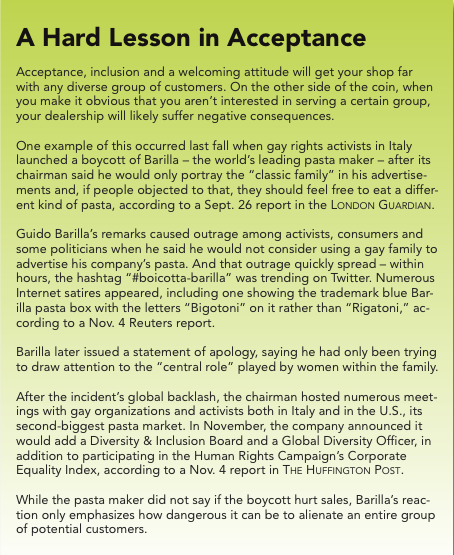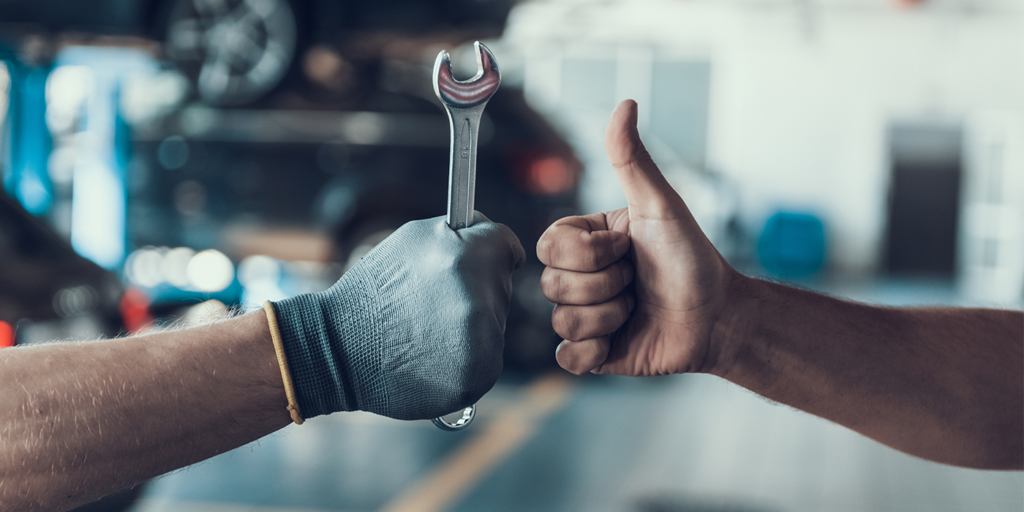 With each passing generation, our population landscape gets more diverse. The majority of communities throughout the U.S. and Canada have a makeup that is very different from a few decades ago.
With each passing generation, our population landscape gets more diverse. The majority of communities throughout the U.S. and Canada have a makeup that is very different from a few decades ago.
With these ever-shifting demographics, business owners are faced with the challenge of constantly reinventing their marketing and customer service efforts if they want to cater to all potential customers. And with the buying power and influence that many of these groups have, smart tire dealers know they need to do just that.
While differing combinations of gender, race, age, religion and ethnicity create a myriad of divergent customer groups, focusing on four large demographic groups – women, Hispanics, senior citizens and the LGBT community (lesbian, gay, bisexual and transgender) – should provide a valuable glimpse at tactics dealers can use to reach out to and retain virtually any customer
Why should you go out of your way to cater to a certain group of customers? Wouldn’t it just be easier to do things one way and hope – or assume – that it appeals to everyone?
Often, the extra effort comes with a big payoff – literally, in this case. For some financial details, check the sidebar on page 38. But there are many other benefits being all-inclusive can bring, including a wider and deeper customer base, better recognition within the community, more highly loyal customers and positive word of mouth advertising.
“Being diverse opens you up to a whole world of customers, which at the end of the day means more sales,” says Corey Miller, president of Halifax, Nova Scotia-based Miller Tirecraft. “There’s no point in limiting yourself to just 75% of the market; you may as well try to reach 100% of it. There’s a business case to support that it’s more profitable. I truly believe when you’re open and inclusive, the logical result is that you attract more customers.”
Community Tire, based in Phoenix, has undertaken two highly successful marketing campaigns, first one for the LGBT community and subsequently one targeting women.
While both groups actually have much in common from a customer standpoint, CEO Howard Fleischmann Sr. says, “The difference between marketing to the female community and the gay community is if you do a good job with women and they trust you, they’re going to come back. If you do that for someone in the gay community, they’re going to come back but they’re going to bring six of their friends. It’s a very good group of customers to have.”
“Women are loyal customers,” agrees Tania Flynn Warminski, vice president of Hermitage, Pa.-based Flynn’s Tire & Auto Service. “Once they find a professional who they know is knowledgeable, honest and values their business, they will not only be loyal to that business, but they will tell all of their friends about it.”
What Matters Most
While these four groups each seek similar basic attributes in a business – after all, everyone wants honest, dependable service at a fair price – there are some nuances when it comes to the values they find most important.
For example, there are four main pillars in every Hispanic cultural area: family, religion, the greater good of the group and more expressive interaction, according to Joe Zubizarreta, COO of Zubi Advertising, a Florida-based U.S. Hispanic market advertising firm.
If you are seeking to attract Hispanic customers, emphasize these pillars in your advertising and promotion without being stereotypical, he recommends, noting, “Understand those values, but don’t be offensive.”
Examples in advertising might include featuring a close-knit family rather than an individual, and avoiding advertising that is self-indulgent by showing how products not only can benefit a customer, but others around that person, as well.
Women’s top focuses in automotive purchases and service are trust, respect and developing a relationship with employees at the store, according to AskPatty.com CEO Jody Devere. “Don’t treat women in a frivolous manner in your advertising and marketing. They are, in fact, serious researchers on- and off-line who tend to be less impulsive and more rational even than men in their purchases.”
Senior citizens focus on respect, image and trust in a tire and automotive service provider, says Dan Hennelly, CEO of The Tire Choice & Total Car Care, headquartered in Ft. Lauderdale, Fla. Excel in those categories, and your dealership will appeal to area retirees.
“We strive to be perfect in all of these categories,” Hennelly says, adding Tire Choice locations are kept impeccable from an image standpoint. “Keeping your guests happy will grow your business long-term. We discuss the importance of empathy and respect when dealing with all of our guests, and the importance of treating every guest like they are a member of your family.”
The LGBT community desires trust, authenticity and inclusion in advertising messages, according to Angela Hughey, president of One Community, an interactive Web and events community for LGBT and allied individuals and businesses.
“The LGBT community, like many others, responds to an authentic desire to be a part of our community, not just advertise to us,” she says. “We look for the brands that support us by demonstrating they are leaders in diversity and inclusion. Here in Arizona, we applaud businesses and organizations that have signed the UNITY Pledge. Nationally, we look to align with com panies that score high on the Human Rights Campaign Corporate Equality Index, or who make public their support for inclusive workplaces, domestic partner benefits or marriage equality.”
Hughey notes brands (PetSmart, Verizon Cox Communications and Apple Computers, for example) that have been an active part in the LGBT community – even when it wasn’t popular to do so – have been rewarded with loyal LGBT and allied customers.
“We respond best to companies that treat us well and include us in their advertising messages,” she adds. “It doesn’t have to hit you over the head with its gay content; it simply can be a family at breakfast that is comprised of kids and two moms, or an image of two guys shopping for new tires. Seeing members of our community doing the everyday things that other average Americans do – it’s those images that we love and make us loyal. We don’t need rainbow flags on everything, just authentic, simple messages of everyday life.”
 Diverse Marketing in Action
Diverse Marketing in Action
By now, you likely have a general idea of why reaching out to divergent customer groups is important. But where do you go from here? Several dealers skilled in customer diversity are willing to share their shops’ strategies and keys to success in this effort.
Senior Citizens
Keeping in mind that senior citizens particularly value trust, The Tire Choice set out about five years ago to review its rating with the Better Business Bureau, focus its leadership and create a company culture to “never let a guest leave unhappy,” Hennelly recalls.
“We reached out to the BBB and created an open dialog, assuring them of our company’s commitment to resolve any and all complaints,” he says. “Within months, we moved our BBB rating to A+, which is where it has been ever since. We do believe this rating is important in the eyes of senior citizens, since it shows a sign of earned trust. We display this rating in our ads and on our website.”
At that time, the dealership also re-evaluated its direct mail strategy, particularly how the campaign applied to certain markets. “For example, we have three stores in The Villages, which is an all-retiree community and has very high income demographics,” Hennelly explains. “We made sure that our ads had images that were more relatable in that market. We advertised golf cart tires and repairs – services that are more tailored to this market – and we made store image and customer satisfaction the highest priorities. These are some of our best stores, mainly because of the loyalty and repeat business.”
According to a small business article titled “Effective Marketing to Senior Citizens” on the Houston Chronicle’s website (chron.com), seniors are more likely to read and respond to direct mail than email and other Web-based marketing strategies.
Is radio or television a big part of your shop’s advertising? The article recommends contacting local stations and asking them to provide you with information about the programming that most often attracts this demographic. This will allow you to purchase advertising slots when the greatest number of seniors is likely to be tuned in.
Hispanics
Regarding Hispanic customers, a sign on your door that says “hablamos Espanol” (“We speak Spanish”) is a good start, Zubizarreta says, adding bilingual signage about the products offered also is a big help. More importantly, make sure someone on your staff is highly fluent in Spanish.
“California in general, and specifically southern California, has a big Hispanic population. I think because we have Spanish speakers in our shop and showroom, there’s a comfort level,” says Hank Feldman, president of Performance Plus Tire & Automotive Superstore in Long Beach, Calif. “Even if their English is good, it still makes them feel more comfortable knowing they have that connection.”
He notes that because Long Beach is one of the most diverse cities in the country – the shop also is close to Cambodian, Vietnamese, Pacific Islander and orthodox Jewish commu nities – the dealership’s staff works hard to be sensitive to the individual needs of various ethnic groups and to be familiar with their respective customs.
“It’s about training our guys to understand what’s important to these customers,” Feldman notes. “It just takes a little research on each group in order to be sensitive to their individual needs.”
Performance Plus’ biggest community event, an annual food drive that fed 850 needy families last year, benefits many different ethnic communities, including Hispanics, he says.
“Being involved in the community is one way to target different demographic groups,” Feldman adds. “If there’s a big population of a certain ethnicity, usually with first- or second-generation immigrants, they tend to live communally. So word of mouth goes a very long way.
“Also in this scenario, traditional forms of advertising may not be good drivers,” he continues. “Newspapers aren’t a key mode of advertising anymore, and Spanish television in this market isn’t really affordable for independent dealers. So word of mouth is the most important channel.”
While it isn’t always the case, Feldman says that Hispanics usually are value shoppers, so Performance Plus carries products that fit all budgets and offers credit options, as well.
“Take the time to properly greet and address the consumer, and make them feel comfortable so they don’t feel that you’re brushing them off or in any way underestimating their ability to purchase based on their looks,” Zubizarreta says. “Don’t automatically think a Hispanic person can only afford a lower-priced product.
“Tire dealers have an advantage because car dealerships have a more costly assumption – that the local guy is going to give them a better deal, even though he may do less in volume than a car dealer,” he adds. “Start relationships with several members of the community and make them feel comfortable enough to be your brand ambassadors.”
Women
In order to improve its position with female customers, Flynn’s remodeled many of its locations inside and out, according to Warminski.
“Females don’t want to wait in the ‘typical’ shop showroom. They want clean restrooms, clean seating, and professional looking and knowledgeable service providers they can trust,” she says.
In order to reach women in the community, Flynn’s regularly submits an article and advertisement in Views & Voices, a regional women’s magazine. The dealership also piloted the Flynn’s Car Talk radio show, for which a female employee is on air for every show.
“We also feature women in our radio ads and TV commercials so that people know there are women working in our locations,” Warminski adds. “We participate in some women’s expos by displaying our tires and providing information on the services we offer. Our female employees are there to answer questions.”
When Community Tire began its campaign geared toward women, Fleischmann joined AskPatty.com and asked for the top 20 automotive questions asked by women. This became the basis for “The Ladies’ Guide to Automotive Repair,” a small book Community Tire created to distribute in its stores, at local businesses and at its community events for women. The book includes a $20 coupon for use at the shop.
“Women are interested in learning,” he says. “They want to know how to check their oil and how to check tire pressure. So our educational events for women have always been well-attended.”
Community Tire also created a series of educational videos demonstrating basic techniques – jumping a car abttery, changing a tire on the side of the road, etc. – featuring a female service advisor.
While Community Tire and Flynn’s don’t approach women differently from a sales and service perspective, they are sensitive to the fact that female customers should be treated equal to their male counterparts.
“The sales approach was probably different in the past, but what we learned through AskPatty changed that,” Fleischmann says. “We used to take a guy into the shop to show them what was wrong, but with a woman we would sit down and explain everything to them. Now we ask women if they’d like to go into the shop.”
“Our sales approach isn’t different for female customers, but we do take special care to make sure they feel heard,” explains Warminski. “For example, if a male and a female come in together with their vehicle, we may ask whose vehicle it is. If it’s the man’s, most questions would probably be best answered by him, the regular driver of the vehicle, but we may say something to the like, ‘Okay, because you drive this vehicle most of the time, let me ask you a few questions.’
“This makes it known that the reason we are asking the man the questions isn’t because we think the woman wouldn’t know the answers, but rather because she’s not the regular driver of the vehicle. If the female is the regular driver of the vehicle, we are sure to ask her the questions, instead.”
 LGBT
LGBT
Summing up Community Tire’s LGBT campaign, Fleischmann lists three components: “marketing tailored to them; a presence in their publications; and being active at their events. If you don’t hit all three pieces, it’s not going to work. That community looks for sincerity and if they don’t see it, you’re going to lose them as fast as you got them.”
Community Tire reached out to the LGBT community long before it was popular to do so. And the shop has reaped the rewards of that effort – last year, roughly 5% of its total tire and service sales were from this group of customers.
“They’re looking for the same thing all of us are looking for: someone they can trust who will treat them with respect,” Fleischmann explains. “They don’t want to be treated like they’re in any way different. But they appreciate sincerity and the extra effort.”
He said that while acceptance has grown, there still are businesses that are not as open-minded. “One local dealer told me he’d take their money, but he’s not going to spend money marketing to them because he doesn’t believe in their lifestyle.”
Howard’s wife, Pat Fleischmann, says LGBT customers are ideal for several reasons: “Most are two-income families without children, so there’s disposable income; most drive pretty nice cars; and they prioritize vehicle maintenance and trust our recommendations.
“It’s simple,” she adds. “We treat everyone with respect. Everyone. We don’t ask for anyone’s sexual orientation when they walk through that door.”
When it comes to marketing and advertising to the LGBT community, the dealership goes all out, creating relevant, fun and edgy initiatives. For example, at a recent annual pride cele- bration – one that brings about 200,000 participants both gay and straight – the shop gave away condoms at its booth, since AIDS is a concern in the area. The wrapper read, “Community Tire Pros: keeping you safe on and off the road.” A banner at the booth was printed with, “The second most important rubber you’ll ever buy,” along with the Community Tire logo.
“We try to have fun and be a little edgy,” Fleischmann says. “We market in some of the more respectable gay publications and we feature women and gay people in our ads.”
The Bigger Picture
For Miller Tirecraft, customer diversity comes naturally because having a diverse staff is a priority.
“Our team goes through diversity training,” Miller says, adding that new employees sign a statement of the dealership’s of values and principles that must be followed. “It makes our staff aware of people’s differences. In our industry, it’s very easy to set sales targets and train folks to operate a tire machine. It’s sometimes a little more challenging to deal with some of those softer areas.”
The dealership has sponsored many different community groups, including being active in Halifax’s family pride parade.
“We would only support a community event that’s there to support diversity,” Miller notes. “We have money in our budget that we use to donate to community events. We may not use it all every year, but it’s there specifically for that purpose.”
Being inclusive with one community group generally will highlight your shop with others, as well, he adds. “For example, the African-Canadian community isn’t the LGBT community, but they see your involvement in that and see that you’re a more open organization.”
Miller Tirecraft’s staff diversity and training sets the dealership apart from the competition, according to Miller, who adds, “I don’t believe folks actively try and discriminate against these groups, but I do think a lot of organizations aren’t aware of what they don’t know. By training all of our team on diversity issues and by highlighting our values statements and inclusiveness statements in our hiring process, that puts us a step ahead of our competition.
“I’d like to think that whether you are a member of the LGBT community or the French community or you’re a woman, etc., you’d be treated the same if you came into one of our stores.”
So while the Golden Rule – “Do unto others as you would have them do unto you” – isn’t the only answer to running a successful business, it certainly is a solid foundation for approaching diverse customer groups.
“Treating everyone the same is all about respect,” Fleischmann notes. “But a smile and a ‘thank you’ doesn’t do it anymore; you have to be way above that.”
If your shop’s approach to diversity could use some updating, the sooner you take action, the better – your dealership’s reputation depends on it.














